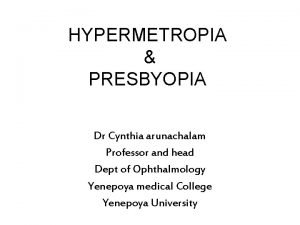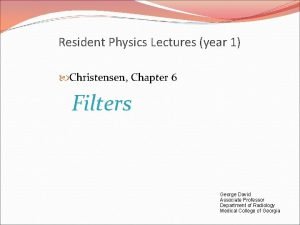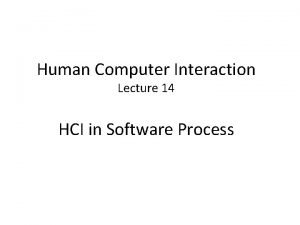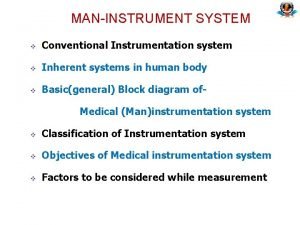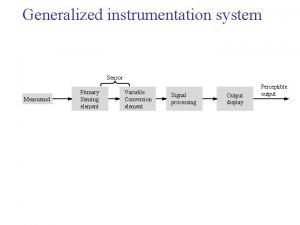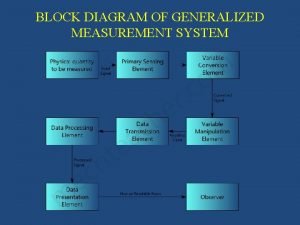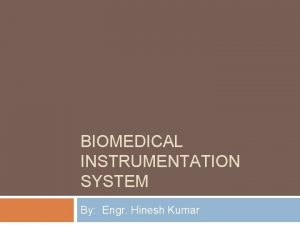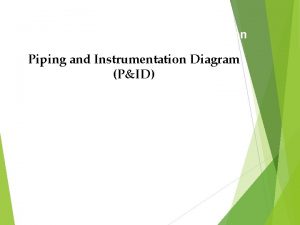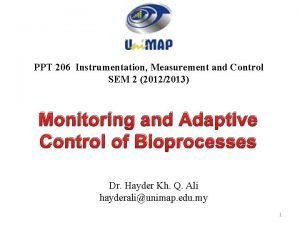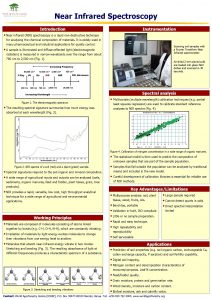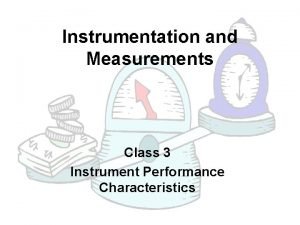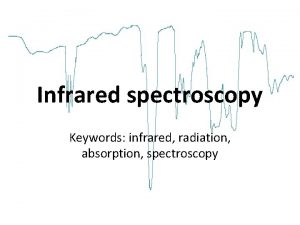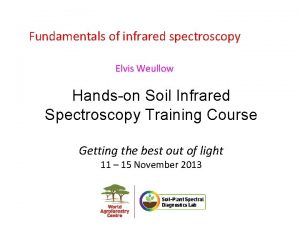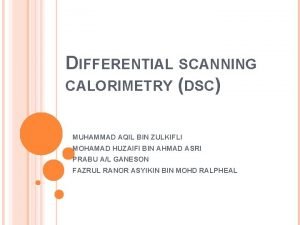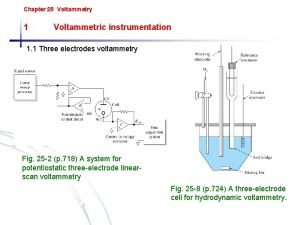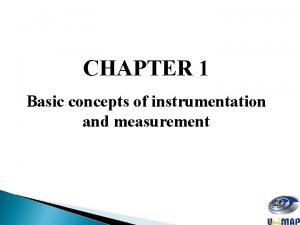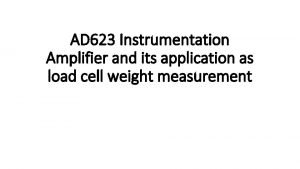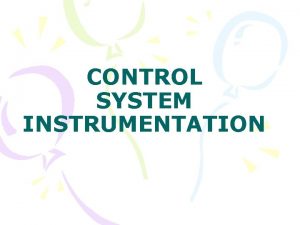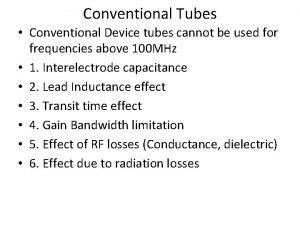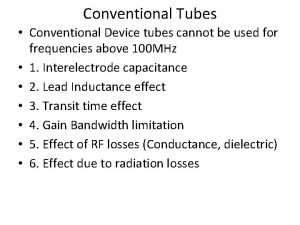MANINSTRUMENT SYSTEM v Conventional Instrumentation system v Inherent




































































- Slides: 68

MAN-INSTRUMENT SYSTEM v Conventional Instrumentation system v Inherent systems in human body v Basic(general) Block diagram of- Medical (Man)instrumentation system v Classification of Instrumentation system v Objectives of Medical instrumentation system v Factors to be considered while measurement

Conventional instrument system COMBINATION OF INPUTS UNKNOWN SYSTEM • Established the relationship between inputs and outputs • Many outputs will show wide range of responses to a given set of inputs

Physiological Systems… Human body contains various types of systems: Vision Hearing Smell Taste Inspired air Sensation Liquid intake Food intake ELECTRICAL MECHANICAL ACOUSTIC THERMAL CHEMICAL HYDRAULIC PNEUMATIC OPTICAL COMPUTER COMMUNICATION CONTROL Identification Speech Behavior Appearance Expired air Liquid waste Food waste

Components in Man – Instrument system Stimulus Control feedback Transducer Signal Transducer equipment conditioning Display Transducer Recording , data processing and transmission of data

Block diagram ……. . : v v Basic(General) block diagram of Medical or Man Instrumentation system. Functional components v v v Measurand (subject)- stimulus Sensors/Transducers Signal conditioner-pre amplifier, signal processing Output devices - Alarams -Display -Data storage -Data transmission -Data recording Control System

Medical(Man) Instrumentation System Block Diagram Control System (Energy Sources) Electric Light Infrared Mech. Ultrasonic calibration Measurend Pre Signal Sensors/ Transducer Amp. Processing Signal conditioner Alarm Display Data storage Data Trans Data Rec

Man(Medical) instrumentation system n n Includes both the human being(living organism) & the instrumentation required for measurement of the parameters related to human being Attempts to measure and understand the internal relationship of the human body organs To help the medical clinician and researchers for obtaining reliable and meaningful measurements from a human being The concept of the man-instrument system is applicable to both clinical and research instrumentation

Classification of instrumentation system n Clinical instrumentation n Research instrumentation Measurements obtained from such Instrumentationn In-vivo measurement n In-vitro measurement

Factors to be cosidered: n Ø Ø Ø Factors to be consider for obtaining reliable and meaningful measurements from a living organism. No endanger to the life of the person No undue pain, discomfort, other undesirable conditions Safety consideration The hospital environment Medical personnel must involved Ethical and legal consideration

Basic objectives of Medical or Man Instrumentation systemØ Ø Ø Information gathering Diagnosis Evaluation Monitoring control

Constraints in design of Medical Instrumentation System: v v v Measurement range(uv) Frequency range(<AF, 0 or Very low freq. ) Additional Constraintsv Inaccessibility of the signal source v Variability of Physiological parameters v Interface among Physiological systems v Transducer interface problems v Higher possibility of artifacts v Safe levels of applied energy v Patient safety consideration v Reliability aspects v Human factor consideration v Government regulations

General Consideration Design of Medical Instrumentation System: v General consideration: v v Environmental Consideration: v v S/N ratio, Stability, atmospheric temperature, pressure, humidity, vibration, radiation, etc Medical Consideration: v v Signal consideration: Types of sensors, sensitivity, range, input impedance, frequency response, accuracy, linearity, reliability, differential or absolute input Invasive or Non-invasive technique, patient discomfort, radiation and heat dissipation, electrical safety, material toxicity, etc. Economic Consideration v Initial cost, cost and availability of consumables and compatibility with exiting equipments

L 3: Sources of Bioelectric Potential n Biosignal/Biopotential o o o The ionic potential originated with the result of electrochemical activity of certain special cells/tissues own monitoring signals, which convey information about the functions they represent. Such signals are associated with nerve conduction, brain activity, heart activity, muscle activity etc Ionic voltage Transducer Electric voltage

L 3: Sources of Bioelectric Potential n Biosignal/Biopotential Such signals: o o o Used for extracting information on a biological systems(physiological systems) Phenomenon that conveys information which is used for diagnosis Process of extracting information could be as simple as feeling pulse of a person on the wrist or as complex as analyzing the structure of internal soft tissues by an ultrasound scanner

Cont. . S. No Signals sources 1 EEG, ENG, EMG Nervous system 2 EOG Occular System 3 ERG Corniel Retinal Position 4 ECG Cardiovascular system 5 PULSE RATE , , 6 BLOOD PRESSURE , , 7 BLOOD FLOW , , 8 PCG Heart valves 9 EMG Muscular system 10 EGG Gastroinstinal track

SOURCES OF BIMEDICAL SIGNALS:

Classifications Biopotentials/Biomedical signals: n Classifications of Biopotentials/Biomedical signals: n Ø Ø Ø Ø q Biopotentials For Examples Bioelctric signals: ECG, EMG, EEG, EOG, ERG, EGG Bioacoustic signals: Blood flow thr Heart valve sound Biomechanical signals: Movement of the chest walls Biochemical signals: p. CO 2, p. O 2 Biomagnetic signal: Magneto. EG Biooptical signal: transmitted/back scattered light Bioimpedance: Galvanic skin resistance Details-

Cont… Ø Bioelctric signals: Ø Bioacoustic signals: Ø Biomechanical signals: Ø Biochemical signals: The electric field generated by the action of many cells constitutes the bioelectric signals. They are generated by nerve or muscle cells, basic source is the cell membrane potential eg ECG, EMG, EEG, EOG, ERG, EGG Such biomedical signals provides information about the underlying phenomena. eg flow of blood in the heart, through the heart’s valve and flow of air through the upper and lower airways and in the lungs Originate from mechanical functions of the biological systems. Includes motion and displacement signals, pressure and flow signals. eg movement of the chest walls in accordance with the respiratory activity. Obtained as a result of chemical measurement of living tissue or from samples analyzed in the lab. eg measurement of p. CO 2, p. O 2 and concentration of various ions in the blood.

Cont… q Ø Biomagnetic signal: Ø Bio-optical signal: Ø Bioimpedance: Extremely weak mag. fields produced by various organs(Brain, Heart, Lungs) it provides imp. inf. which is not provided by bioelectric signals eg magneto. En. G from the brain. Result of optical functions of the biological systems, occurring either naturally or induced by the measurement process eg blood oxygenation may be estimated by measuring the transmitted/back scattered light from a tissue at different wavelengths. The impedance of the tissue is a source of important information concerning its composition, blood distribution and blood volume etc. It is also obtained by injecting current in the tissue and measuring voltage drop across tissue Impedance. eg Galvanic skin resistance and the measurement of respiration rate based on bioimpedance technique. Such signal comprises resting & action potential

Action potential & Resting potential n n Source for Biopotential nerve cells and muscle cells Resting potential , Action potential States of cell: Polarised state Depolarised state Repolarised state (Semi permeable membrane): Depolarisation phase and Repolarisation phase Electrical activity associated with one contraction in a muscle

Cont. . Typical cell potential waveform Typical terms: n Ø Ø Ø Ø Resting potential and action potential Depolarization and Repolarization phase Sodium pump All-or-nothing law Net height of the action potential Absolute refractory period Relative refractory period Propagation rate/Nerve conduction rate/conduction velocity

Polarized state and Resting Potential. .

Depolarized state and Action Potential. .

Na+ Action potential & Resting potential n Polarised state Na+ K+ Cl- K+ + Na Cl- Na+ Cl- + K Na+ Na+ K+ Cl- Na+ Cl- + Semi permeable K Na+ membrane + Na -70 mv

Action potential & Resting potential n Polarised state K+ K+ 20 mv K+ Na+Cl Na+ Cl. Cl- K+ Na+ + K K+ Semi permeable membrane

CELL POTENTIAL:

CELL POTENTIAL:

Cell membrane potential process: Dept. of Electronics and Telecommunication Engineering

All or Nothing law: The action potential is always the same for any given cell irrespective of method by which cell is excited and intensity of the stimulus. Net Height of the action potential: Difference between the peak of the action potential and the resting Potential. Absolute refractory period: Brief period of time during which the cell can not respond to any new stimulus(1 msec in nerve cells) Relative refractory period: Period of time during which another action potential can be obtained with a much stonger stimulation (several msec ). Its result of after potential. Dept. of Electronics and Telecommunication Engineering

Propagation rate: The rate at which an action potential moves down a fiber or propagated from cell to cell is called propagation rate. ( Nerve conduction rate: 20 -140 m/sec, Heart muscle: 0. 2 -0. 4 m/sec, special time delay fibers between the atria and venticles: 0. 03 -0. 05 m/sec Dept. of Electronics and Telecommunication Engineering

L 4: Different bioelectric Signals: n n n Importance of various bioelectric signals Electrical activity of various cells(body organs ) results in biopotentials. Nature and important features of bio-Signals like ECG, EEG, EMG

Different bioelectric signals n The primary characteristics of typical bioelectric signals: Parameter Primary Signal characteristics Frequency range signal Amplitude Type of Electrode ECG 0. 05 to 120 Hz (100 Hz) 0. 1 - 5 m. V (1 m. V) Skin electrode EEG 0. 1 to 100 Hz (100 Hz) 2 - 200 u. V (50 u. V) Scalp electrode EMG 5 to 3000 Hz (100 Hz) 0. 1 - 5 m. V (50 u. V) Needle electrode ERG 0 -20 Hz 0. 5 uv-1 m. V Contact electrode EOG 0 -100 Hz 10 uv-3. 5 m. V Contact electrode

Cont… n features of important biomedical signals such as- ECG

ELECTRO-CONDUCTION OF HEART MUSCLES: Dept. of Electronics and Telecommunication Engineering

features of important biomedical signals such as- ECG

ECG SIGNAL : Dept. of Electronics and Telecommunication Engineering

EEG SIGNAL : Dept. of Electronics and Telecommunication Engineering

EMG SIGNAL : VM Umale Dept. of Electronics and Telecommunication Engineering

L 5: Electrode theory. Basic electrode, Electrodes for ECG n Electrode theory n Need, types of Bio-potential electrodes. n Basic electrode theory n Various Electrodes for ECG.

ELECTRODE - ELECTROLYTE & ELECTROLYTETISSUE INTERFACE Dept. of Electronics and Telecommunication Engineering

Electric equivalent circuits (warburg) Dept. of Electronics and Telecommunication Engineering

: Dept. of Electronics and Telecommunication Engineering

Electrode theory- Basic electrode, n Need & Types of Bio-potential electrodes n n n Surface electrodes Deep seated electrode Factors to be consider while measurements: Ø Careful and suitable selection of electrodes for satisfactory record of bioelectric signal. Ø Comfortable for the patients to wear over long period Ø They should not produce any moving artefacts Ø Convenient in practical applications Ø Good contact with skin (for low contact impedance)

Cont. . n The characteristics of a metalic/nonmetalic surface electrodes depends uponn Condition at metal-electrolyte interface n Electrolyte –skin interface n Quality of electrolytes n Electrode properties Why electrode jelly is required while measurements of biopotential signals?

Cont. . n Electrode Potentials All electrode potentials are measured wrt a ref. Electrodes n Ref. Electrodes-Hydrogen electrode (H absorbed on platinum back -Calomel electrode Metal Ionic symbol Electrode potentials of few metal electrodes wrt Hydrogen Potential(Volt) n Aluminium Al+++ -1. 66 Iron Fe++ -0. 44 Lead Pb++ -0. 12 Hydrogen H+ -0. 0 Copper C++ +0. 34 Silver Ag+ +0. 80 Platinum Pt+ +1. 2 gold Au+ +1. 69

Cont. . q potential between Electrode s in electrolyte Electode Metal Electrolyte Potential difference between Electrode (m. V) Stainless steel Saline 10 silver Saline 9. 4 Silver-silver chloride Saline 2. 5 Silver-silver chloride (11 mm disc) ECG paste 0. 47 Silver-silver chloride (sponge) ECG paste 0. 2

L 6: Electrodes for ECG, EEG, EMG n Electrodes for ECG. n Electrodes for EEG, n Electrodes for EMG, n Biochemical Electrodes

Electrodes for ECG, EEG, EMG Electrodes are used to pickup the biopotentials from the surface of the body of from inside the cells. Basic electrodes are classified as: v v v Skin surface electrodes Needle electrodes Microelectrodes

Electrodes for ECG, EEG, EMG n Various Electrodes used for the measurement or recording of ECG signal. n v v v v Immersion electodes(not used now) Limb electrodes Suction cup electrodes Floating electrodes Spray –on electrodes Pregelled disposable electrode Pasteless (dry) electrodes Air –jet ECG electrodes

ECG plate electrode. The electrode is usually Fastened to the arm or leg with a perforated Rubber strap which keeps it in position during ECG recording Light weight floating Electrode with press Stud for long term monitoring ECG Electrodes

ECG Electrodes

Disposable pre-gelled ECG Electrode. A porous tape overlaying placed over the electrode resists perspiration and Ensures positive placement Under stress conditions Air –Jet ECG Electrodes

Suction cup electrode (Unipolar chest ECG Electrode. ) Floating type skin surface ECG Electrodes 53

Electrodes for ECG, EEG, EMG n Various Electrodes used for the measurement or recording of EEG signal. v v v Scalp surface electrodes (chlorided silver discs) Ear-clip electrodes (reference electrode) Small needle electrodes Silver ball or pellet electrodes(exposed cortex, high resistance) Pad electrode(silver ball is belled out at the end and padded with a sponge) Chlorided silver wire in plastic cup electrodes

EEG Electrode which can Be applied to the surface Of the skin by an adhesive tape. Ear-clip Electrodes & EEG scalp surface Electrodes EEG Electrodes

EEG Electrodes

Electrodes for ECG, EEG, EMG n Various Electrodes used for the measurement or recording of EMG signal. v Needle electrodes v v n Monopolar Bipolar Concentric core needle Multi-element needle electrodes Biochemical Electrodes n n n Reference electrode p. H electrodes Blood Gas electrode

EMG Electrodes

Micro Electrodes

Metal micro-electrodes

Biochemical Electrodes n Biochemical Electrodes n n n Reference electrode p. H electrodes Blood Gas electrode v p. O 2 Electrode v p. CO 2 Electrode

L 7, L 8: Nernst eq. & Skin contact impedance n Nernst equation n Skin contact impedance measurement n Motion artifacts

Nernst Equation: VM Umale Dept. of Electronics and Telecommunication Engineering

SKIN CONTACT IMPEDANCE MEASUREMENT: Dept. of Electronics and Telecommunication Engineering

: Dept. of Electronics and Telecommunication Engineering

L 9: Physiological System of Heart v Physiology of Heart v Physiological System of Heart- Hydraulic system v Physiological System of Heart- electrical conduction

Conducting System of Heart

Thanks
 Classifying adjectives
Classifying adjectives Inherent powers examples
Inherent powers examples Inherent drama
Inherent drama Inherent powers
Inherent powers Inherent powers
Inherent powers Inherent powers
Inherent powers Inherent vice definition
Inherent vice definition Characteristics of rights
Characteristics of rights Credit union enterprise risk management
Credit union enterprise risk management Ar = ir x cr x dr
Ar = ir x cr x dr Inherent risks examples
Inherent risks examples Inherent risk
Inherent risk Inherent vice of capitalism
Inherent vice of capitalism Efpia
Efpia Inherent rather than circumstantial
Inherent rather than circumstantial What is inherent powers
What is inherent powers Classification of discontinuities
Classification of discontinuities Inherent drama advertising example
Inherent drama advertising example Calculation of goodwill in partnership
Calculation of goodwill in partnership Inherent thoughtfulness and emotionality
Inherent thoughtfulness and emotionality Total hypermetropia
Total hypermetropia X ray tube filter
X ray tube filter Expressed implied and inherent powers
Expressed implied and inherent powers Inherent resolve meaning
Inherent resolve meaning Absolute hypermetropia
Absolute hypermetropia Inherent optical properties
Inherent optical properties Powers of congress
Powers of congress What is inherent instability
What is inherent instability Formality gap in hci
Formality gap in hci Exi inherent
Exi inherent Man instrument system block diagram
Man instrument system block diagram Primary sensing element example
Primary sensing element example Block diagram of measuring system
Block diagram of measuring system Components of medical instrumentation system
Components of medical instrumentation system Institutional catering definition
Institutional catering definition Computer consists of
Computer consists of Tipe penyelenggaraan makanan
Tipe penyelenggaraan makanan Linguistic branch
Linguistic branch Conventional radio system
Conventional radio system Conventional marketing system
Conventional marketing system Vienna conference on instrumentation
Vienna conference on instrumentation Mtbf and maturity
Mtbf and maturity Piping and instrumentation diagrams
Piping and instrumentation diagrams Split range control
Split range control Process control instrumentation technology
Process control instrumentation technology Palm up fulcrum finger rest
Palm up fulcrum finger rest Gas turbine instrumentation
Gas turbine instrumentation Measurement and instrumentation ppt
Measurement and instrumentation ppt Intel pin tool tutorial
Intel pin tool tutorial Piping and instrumentation diagram symbols
Piping and instrumentation diagram symbols Power supply for nim instrumentation
Power supply for nim instrumentation Near infrared spectroscopy instrumentation
Near infrared spectroscopy instrumentation Layers of protection
Layers of protection Dentalelle
Dentalelle Dead space of instrument
Dead space of instrument Ir spectroscopy instrumentation
Ir spectroscopy instrumentation What are transmitters
What are transmitters Smart plant instrumentation
Smart plant instrumentation Ir instrumentation
Ir instrumentation Emg instrumentation
Emg instrumentation Ee8403 measurements and instrumentation
Ee8403 measurements and instrumentation Dsc principle and instrumentation
Dsc principle and instrumentation Instrument for research data collection
Instrument for research data collection Chapter 3 in research parts
Chapter 3 in research parts Describe voltammetric instrumentation
Describe voltammetric instrumentation Basic concepts of instrumentation
Basic concepts of instrumentation Ad623
Ad623 Machine protection systems
Machine protection systems Binary instrumentation
Binary instrumentation




















